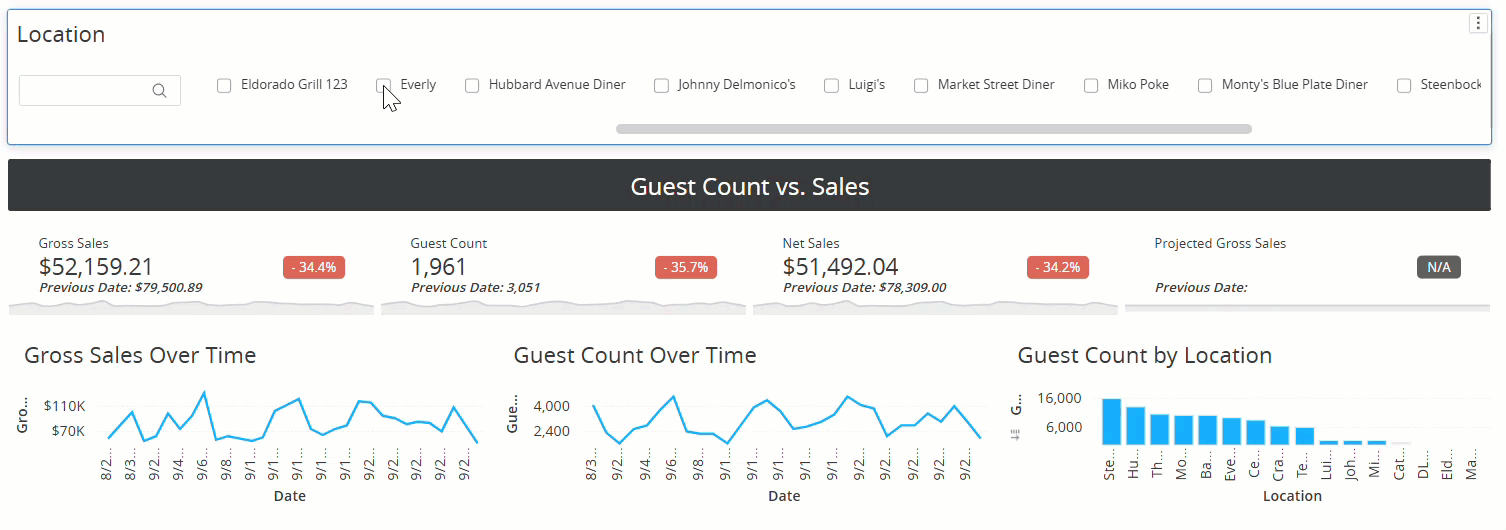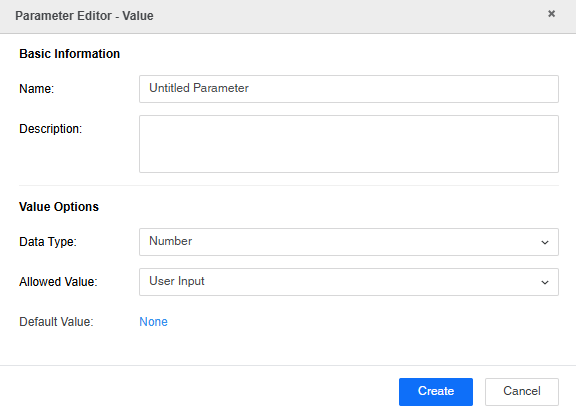This feature is in beta for select customers. Contact your CSM for more information.
Parameter selectors are customized dashboard controls that, when added to a dashboard, enable users to switch views and run what-if scenarios.
Parameters are first created in Intelligence. There are two different types of parameters including value and element list. Once a parameter is created and added to the datasets panel, it can be added to a parameter selector or to the filter panel to have a dynamic selection filter. Parameter filters will appear as a filter option in view mode. Parameter selectors will appear as a dashboard element.
When a parameter is selected as a filter qualification for a visualization, then the parameter will control the visualization. Multiple parameter selectors or filters can be added to a dashboard. Visualizations must be linked to each parameter to be affected by any selections made to the parameter selectors/filters. When selection(s) are made on a parameter selector or filter, the visualization will update to reflect the selections made.
Using parameters on a dashboard involves the following steps:
Create a parameter.
Add a parameter to a parameter selector or as a filter.
Add the parameter as a filter qualification for a visualization.
Use the parameter.
Parameter Types and Creation Methods
Parameter Types
Parameter Type | Description and Use Case |
|---|---|
Value | A fixed value such as a specific date, number, or text string. Value parameters are used to create metrics to apply to the dashboard. Value parameters are best for setting goals, thresholds or reusable constants. These are used to set parameters that won’t change or will rarely change, such as always considering a 10% discount in sales projections. |
Element List | A parameter created from an available attribute. Element list parameters are best for filtering down data by one or several attribute elements. These are used to set parameters that users can interact with, filtering data by choosing elements from a list. |
Creation Method
Parameters can be added to dashboards as a parameter filter or onto a parameter selector. Only visualizations with the parameter(s) as a filter qualification will be updated as the parameters are controlled.
Creation Method | Description and Use Case |
|---|---|
Filter | Adds the parameter to the filter panel to create a dynamic filter. This will apply to the dashboard as a filter that can be controlled in View Mode from the filter options.
|
Parameter Selector | Adds a a parameter selector to the dashboard as a dashboard object. In View Mode, parameters can be controlled from the selector. The display of the selector will be determined by how it is configured in edit mode. |
Create a Parameter
Before being used on a dashboard, a parameter must first be created. To create a parameter, follow these steps:
Click steps to expand for additional information and images.
1) Open a dashboard into edit mode.
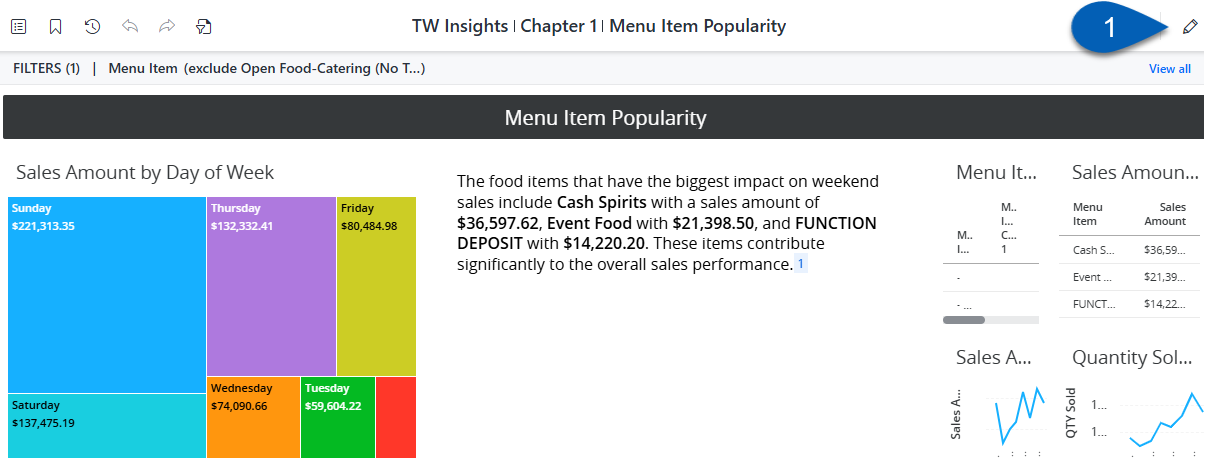
2) Click the Datasets panel menu button.
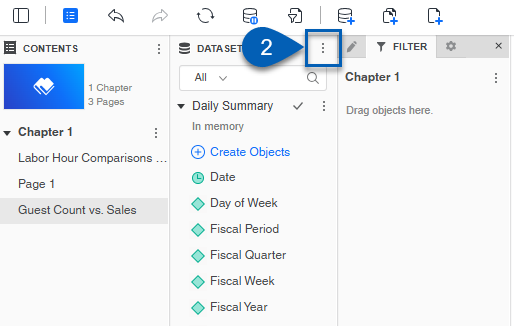
3) From the dropdown, select Create Parameter.
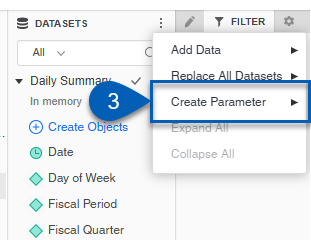
4) Select whether to create a Value or Element List parameter
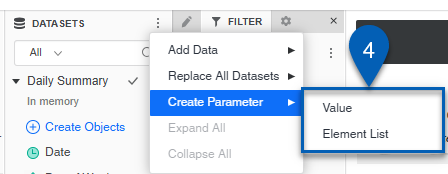
5) Configure the parameter. The parameter options will be dependent on the type of parameter
Value Parameter | Element List Parameter |
|---|---|
Requires the following:
| Requires the following:
|
|
|
6) Once the selections have been made in the Parameter Editor, click Create.
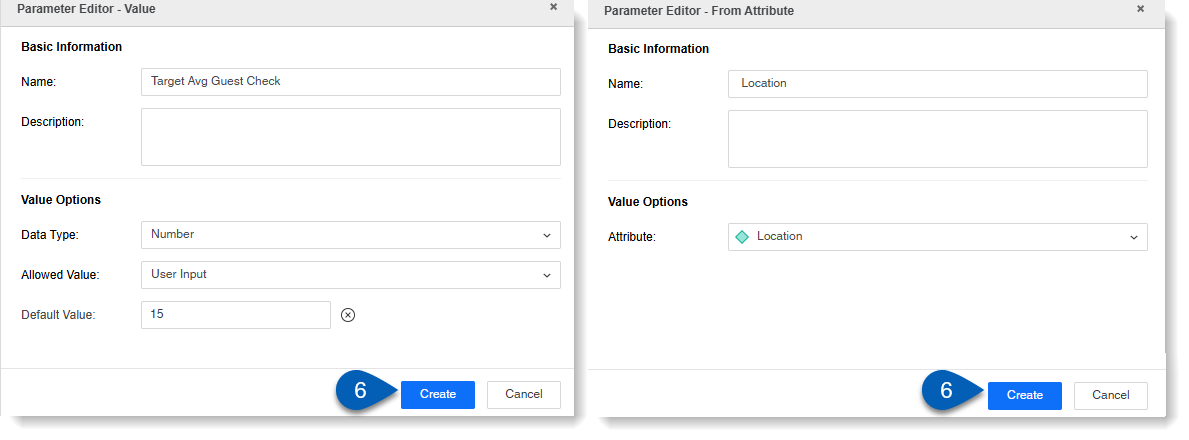
7) The new parameter will now be listed in the Parameters section on the datasets list and available for use. Parameters use a blue icon.
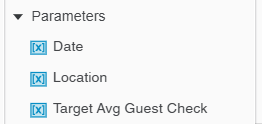
From an Attribute
Parameters can also be created directly from an attribute that has already been added to the Datasets panel. To create a parameter from an attribute, follow these steps:
Click steps to expand for additional information and images.
1) On the Datasets panel, locate the attribute that should be made into a parameter.

2) Right click the attribute.
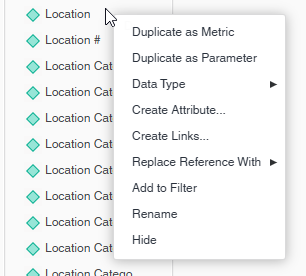
3) From the option menu, select Duplicate as Parameter.
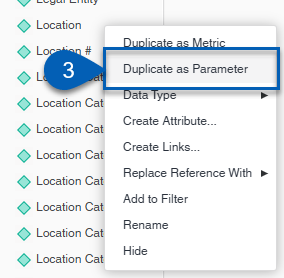
4) The new parameter will appear at the bottom of the list.

To edit the parameter, right click and click Edit.
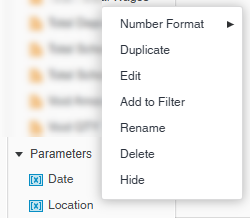
Add a Parameter Selector or Filter
Add a Parameter Selector
To add a parameter selector, follow these steps:
Click steps to expand for additional information and images.
1) From the top center ribbon actions, click the Filter button.

2) From the dropdown, click Parameter Selector.

3) The parameter selector will be added to the page.
The parameter can be moved or resized as needed.

4) On the datasets panel, locate the parameter that needs to be added to the selector.
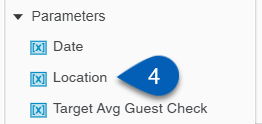
5) Drag and drop the parameter onto the parameter selector.
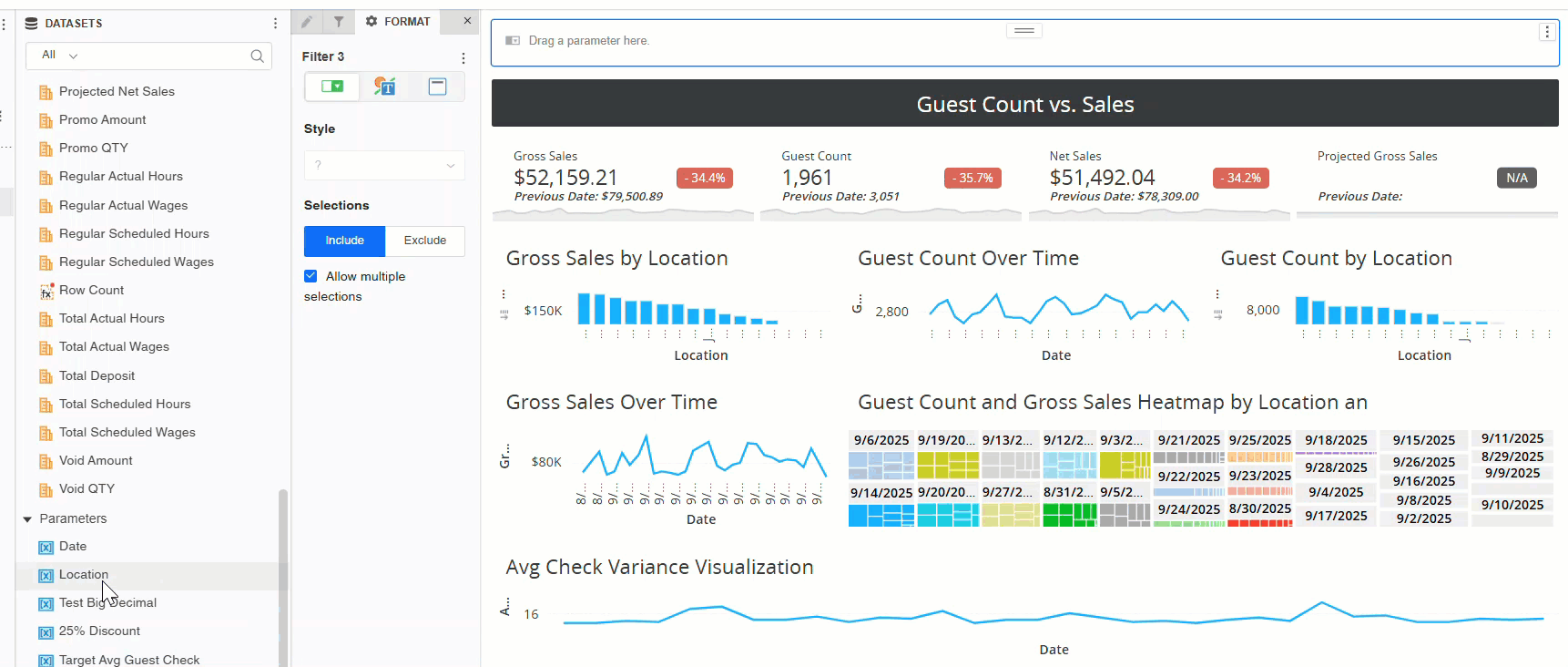
The parameter will be added to the selector.
6) To edit the display or settings for the selector, click the menu button.
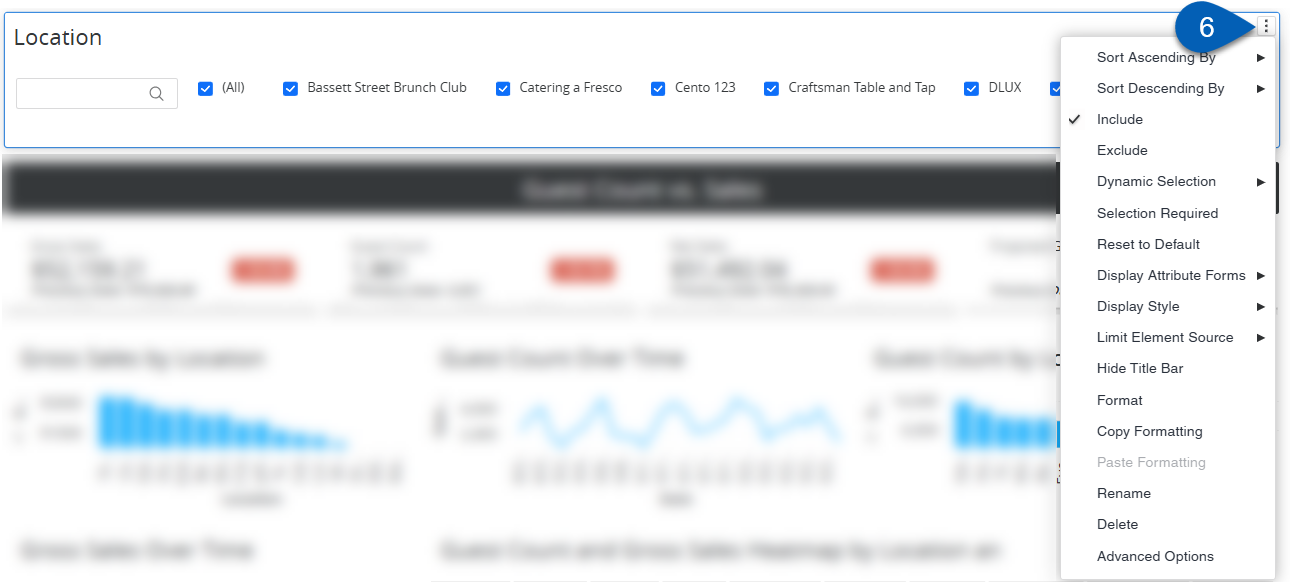
7) Select an option from the menu. Users will have the following options:
Selector Menu Option | Description |
|---|---|
Sort Ascending By | Sorts the parameter options ascending by the selection. |
Sort Descending By | Sorts the parameter options descending by the selection. |
Include | When selected, the parameter selection(s) will be included in the data. |
Exclude | When selected, the parameter selection(s) will be excluded from the data. |
Dynamic Selection | Set a dynamic selection. This is not available for every parameter. |
Selection Required | Require a selection on this parameter. |
Reset to Default | Resets to the default settings. |
Display Attribute Forms | Selects attribute forms to display. The options available will vary based on the attribute selected. |
Display Style | Opens the style options for how the parameter options are displayed on the selector. Ex. Search, checkboxes, radio buttons, slider, link, drop-down. |
Limit Element Source | Select the source of the data. Select one dataset, multiple datasets, or all datasets. |
Hide Title Bar | Hides/Shows the title bar of the selector. |
Format | Opens the Format tab on the Editor panel. |
Copy Formatting | Copies the formatting of the selector. |
Paste Formatting | Pastes any copied formatting to this dashboard object. |
Rename | Enables editing of the selector’s name. |
Delete | Deletes the parameter. |
Advanced Options | Opens the option to rename the parameter. |
Once set, the parameter selector will be available for use.
Add a Parameter Filter
To add a parameter filter, follow these steps:
Click steps to expand for additional information and images.
1) On the datasets panel, locate the parameter that needs to be added as a filter.
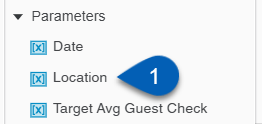
2) Drag and drop the parameter to the filter panel.
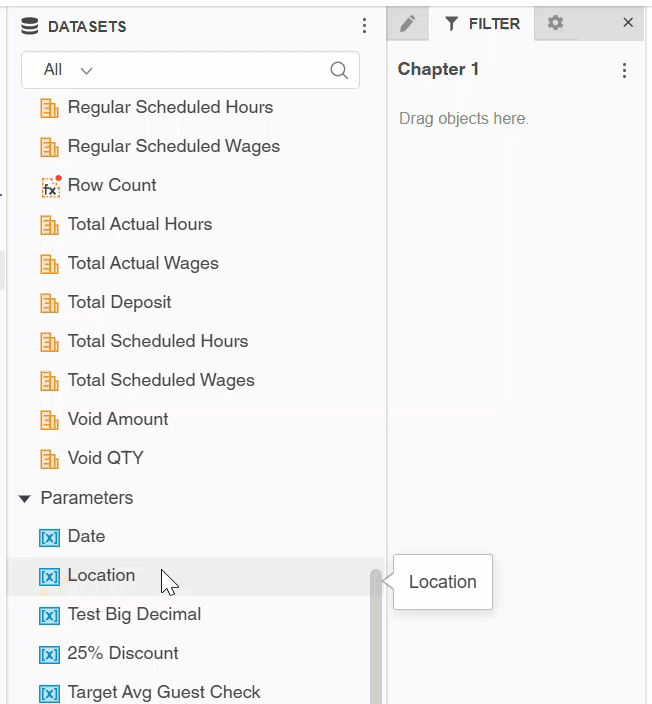
3) To edit the parameter filter settings, click the parameter menu icon.

7) Select an option from the menu. Users will have the following options:
Selector Menu Option | Description |
|---|---|
Sort Ascending By | Sorts the parameter options ascending by the selection. |
Sort Descending By | Sorts the parameter options descending by the selection. |
Include | When selected, the parameter selection(s) will be included in the data. |
Exclude | When selected, the parameter selection(s) will be excluded from the data. |
Show Option for All | Show/hide the option to select All. |
Dynamic Selection | Set a dynamic selection. This is not available for every parameter. |
Selection Required | Require a selection on this parameter. |
Reset to Default | Resets to the default settings. |
Display Attribute Forms | Selects attribute forms to display. The options available will vary based on the attribute selected. |
Display Style | Opens the style options for how the parameter options are displayed on the selector. Ex. Search, checkboxes, radio buttons, slider, link, drop-down. |
Limit Element Source | Select the source of the data. Select one dataset, multiple datasets, or all datasets. |
Filter by Rank | Filters the parameter based on a selected metric or attribute. |
Delete | Deletes the parameter filter. |
Advanced Options | Opens the option to rename the parameter. |
Once set, the parameter filter will be ready for use.
Use a Value Parameter in a Created Metric
To use a value parameter in a metric, follow these steps:
Click steps to expand for additional information and images.
1) At the top of the Datasets panel, click Create Objects.
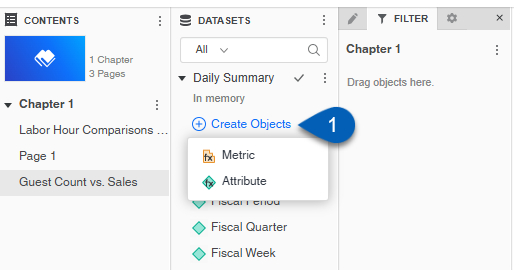
2) From the dropdown, select Metric.

3) Use the formula editor to enter a formula. The value parameter should be used in the metric formula.
When the parameter is used in the metric calculation, the value set in the parameter will be used in the calculation.
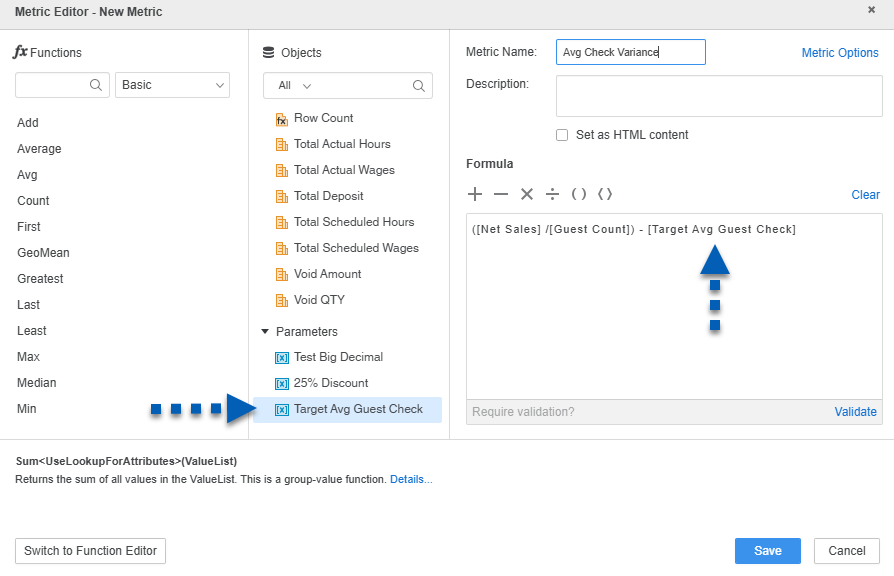
Read more about creating metrics.
4) Save the metric.

The metric will be added to the datasets panel and is now available for use in the dashboard.
Set Visualization Filter Qualifications
Parameter filters and selectors only control the visualizations that the parameter in the filter/selector is linked to. To link a parameter to a visualization, it must be set as a filter qualification. To set visualization filter qualifications, follow these steps:
Click steps to expand for additional information and images.
1) Hover over the visualization that needs to be linked to the parameter filter/selector. This will enable the visualization options.
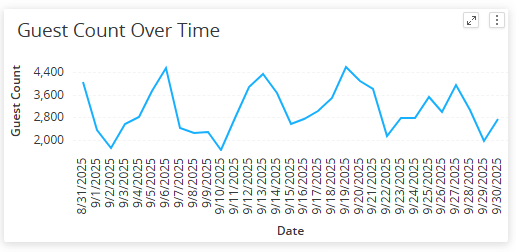
2) When the menu button is available, click the menu button.
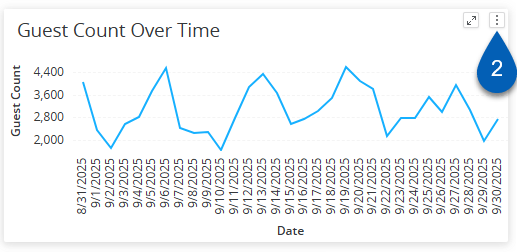
3) From the menu, select Edit Filter.

This will open the Advanced Filter Editor for the visualization.
4) In the Advanced Filter Editor, click Add New Qualification.
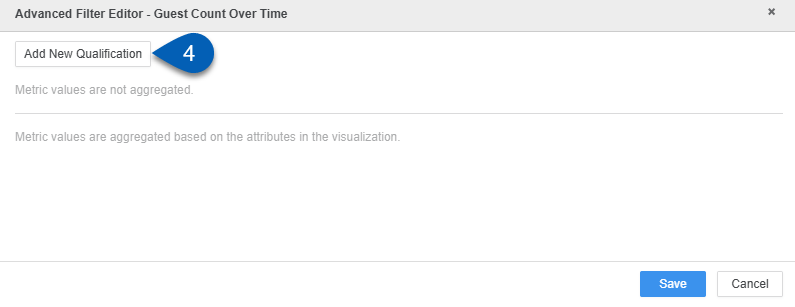
5) Use the search or scroll to locate the parameter.
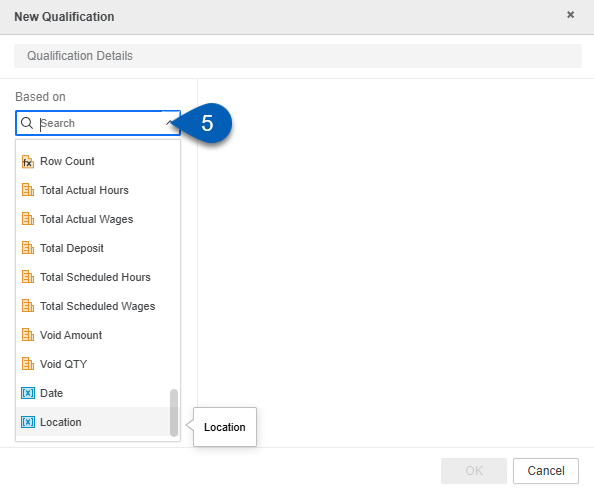
6) Select the parameter that is on the filter or selector.

7) Click OK.

8) Once the parameter is added. Click Save.
If the visualization needs to be linked to more parameters, click Add New Qualification and repeat the steps as necessary.

Repeat these steps for each visualization that should be linked to any parameter(s). Once the visualizations are linked to the parameters, they will be controlled by the parameter selections.
Use a Parameter
Parameter filters and selectors can also be used in view mode.
Use a Filter Parameter
Parameter filters appear in the filter options in view mode. To access, click the filter button  in the top right corner. From the filter options, click the name of the parameter, make the selections, and then click Apply. The example below utilizes the Checkbox display style, and the filter is set to include the parameter selections. Once Apply is clicked, the connected visualization(s) will update to represent the data based on the selection(s).
in the top right corner. From the filter options, click the name of the parameter, make the selections, and then click Apply. The example below utilizes the Checkbox display style, and the filter is set to include the parameter selections. Once Apply is clicked, the connected visualization(s) will update to represent the data based on the selection(s).
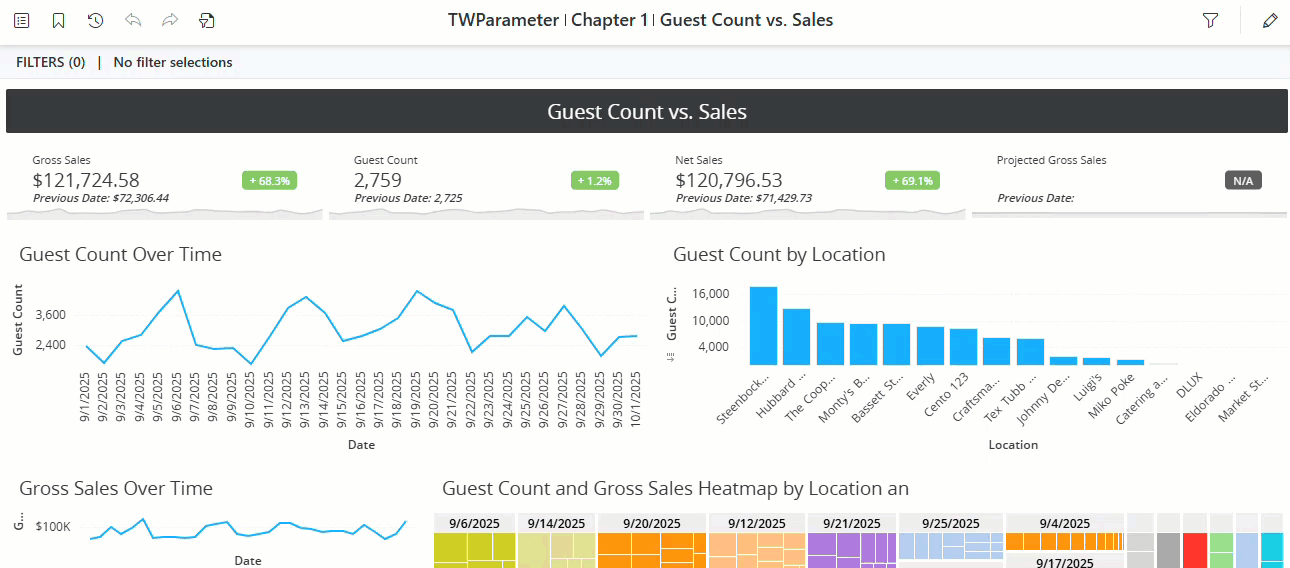
Use a Parameter Selector
Parameter selectors appear as an object on the dashboard. To use a parameter selector, engage with the parameter controls. The example below utilizes the Checkbox display style, and the selector is set to include the parameter selections. When the boxes are checked, the connected visualization(s) will update to represent the data based on the selection(s).
To edit the selector settings, return to edit mode and click the selector’s menu button for options.
